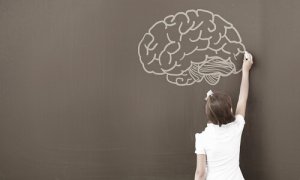Why Do Psychologists Use the WISC Test?

As we all know, health professionals have different tools at their disposal to evaluate the potential problems of those that come for a consultation. In the case of psychologists, they mostly use standardized tests. As far as children go, one of the most well-known and used is the WISC test.
Despite being so widespread, not many people understand exactly what it assesses or how it can help in clinical and educational environments. Because of that, in this article, we’re going to try to explain what this test consists of and why it’s one of the tools that psychologists use the most.

What’s the goal of the WISC test?
WISC is a test that psychologists use to evaluate a child’s cognitive functioning. Brain activity can be evaluated in functions such as memory, attention, processing speed, language, and executive functions. These are fundamental for the adequate development of activities in children, both social and cognitive.
Therefore, one of the test’s goals is to be a starting point for making decisions about a child’s educational journey. This is due to the test’s ability to identify both strengths and weaknesses.
At a clinical level, this test identifies difficulties or cognitive failures associated with certain disorders. In the case of learning disorders, it’s absolutely essential, as it helps to identify the main problems.
What do psychologists take into account when they use the WISC?
During the application, interpretation, and delivery of the report, psychologists must take into account different aspects that come together to reinforce the reliability of the results. Also, they need to pay attention to two areas of interest: the quantitative and qualitative data the test offers.
Quantitative aspects
To properly explain this aspect, we must take different characteristics into account. One of them is that there are multiple sub-tests and each of them gives a specific score. Experts use these scores to generate a scale; they’ll compare the person’s score with the average score for their age range.
This process is conducted in order to see whether the score obtained is the expected one for the child’s age or if it’s higher or lower.
In the case of the WISC test, the average score is between eight and 11 points. A score below eight indicates that there are difficulties in an area. On the contrary, a score above 11 indicates that their abilities are higher than the average for their age group.
Experts can also derive different indices from these tests, which are complementary scores. These indices help consolidate the information regarding some specific functions and help reinforce the figures obtained.
When the scores are between 85 and 115, the capabilities fall within the child’s age range. Some of the indices are:
- Verbal comprehension. It assesses the ability to reason and express oneself verbally. In addition, experts can observe the ability to form concepts.
- Visuospatial functions. The ability to understand spatial relationships, build geometric designs from a model, and evaluate details.
- Fluent reasoning. Measures the ability to use reasoning in order to identify and apply rules.
- Working memory. This is the ability to attend to and manipulate verbal and visual information in a mental way.
- Processing speed. Assesses the ability to effectively and quickly explore, discriminate, and sort simple visual information.
Quantitative aspects
On the other hand, we have qualitative aspects, which are equally important for the effective use of the WISC test. Through them, the results given by the test can be supported and personalized in a more appropriate manner. In this case, aspects observed during the consultation and application of the tool must be taken into account.
The first relevant aspect is the observation and recording of the child’s attitude and behavior while the activity is being carried out. The experts takes into account aspects such as:
- Level of collaboration.
- Tolerance to frustration.
- Handling of difficulties.
- Compensation tools.
- State of mind.
- Non-verbal behavior.
- Motor behavior.
- Personal appearance.
During the assessment, it’s also important for the experts to take other factors into account. However, in this case, you have to do this without the help of extra scores. These strategies can be useful at the time you start the management process.
Therefore, finding out if the child acquires information in a better way through a visual or auditory canal is a real advantage when it comes to enhancing their learning.

The usefulness of the WISC test in the educational field
One of the main goals of the WISC test in the educational field is the establishment of cognitive skills in children with special educational needs. These may include learning disorders, gifting, and intellectual disability, among others.
On the other hand, they help value both the abilities and the difficulties these children may have. All this can facilitate the personalization of the teaching-learning process, placing teachers and psychologists in an ideal position to optimize ways of motivating the child’s learning.
Finally, by means of the WISC test, you can predict the academic performance of each of the children. This is due to the fact that multiple cognitive functions can be evaluated from several different points of view.
These functions can be related to concepts necessary to develop specific aspects of learning. For example, they need a good foundation in language in order to correctly develop the reading-writing process.
The usefulness of the WISC in the clinical field
The WISC test is also widely used in the clinical field. Firstly, it’s useful for collecting information to make the initial main diagnosis, as well as the differential diagnosis of psychological, neurological, or psychiatric disorders. The cognitive effects can be found especially in illnesses or disorders.
On the other hand, it’s useful when preparing and developing assistance programs. With the results it gives experts, they can discover the child’s strengths.
Conclusion
Finally, it’s important to note that this is one of the most widely-used tests nowadays, for two reasons:
- In a clinical environment, it helps experts make diagnoses.
- In a non-clinical environment, it gives experts a profile of a child’s most and least developed skills.
By assessing different cognitive functions, it gives comprehensive information regarding all major aspects. Because of this, when this test is conducted on a child, it isn’t necessarily because they suspect the child has some form of disorder or illness.
All cited sources were thoroughly reviewed by our team to ensure their quality, reliability, currency, and validity. The bibliography of this article was considered reliable and of academic or scientific accuracy.
- Brenlla, M. E. (2013). Interpretación del WISC-IV: puntuaciones compuestas y modelos chc. Ciencias Psicológicas, 7(2), 183-197.
- Campos, J. A. A. (2019). Escala de inteligencia de Wechsler para niños, quinta edición: WISC-V. Universitat de Barcelona.
- Rodríguez, M. A., & Vizcarra, M. B. (2018). Uso del WISC-III en Chile: Análisis de fortalezas y limitaciones según la percepción de los psicólogos. Revista de psicología (Santiago), 27(2), 36-48. https://doi.org/10.5354/0719-0581.2019.52316
This text is provided for informational purposes only and does not replace consultation with a professional. If in doubt, consult your specialist.








